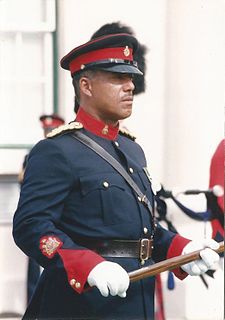
The Armed Forces of the Philippines (AFP) are the military forces of the Philippines. It consists of three main service branches; the Army, the Air Force, and the Navy. The President of the Philippines is the Commander-in-Chief of the AFP and forms military policy with the Department of National Defense, an executive department acting as the principal organ by which military policy is carried out, while the Chairman of the Joint Chiefs serves as the overall commander and the highest-ranking officer in the AFP. The Philippine Coast Guard also serves as an attached service of the AFP in wartime. Military service is entirely voluntary.

Warrant officer (WO) is a rank or category of ranks in the armed forces of many countries. Depending on the country, service, or historical context, warrant officers are sometimes classified as the most junior of the commissioned ranks, the most senior of the non-commissioned officer (NCO) ranks, or in a separate category of their own. Warrant officer ranks are especially prominent in the militaries of Commonwealth nations and the United States.
A lieutenant is a junior commissioned officer in the armed forces, fire services, police and other organizations of many nations.

A non-commissioned officer (NCO) is a military officer who has not earned a commission. Non-commissioned officers usually obtain their position of authority by promotion through the enlisted ranks. In contrast, commissioned officers usually enter directly from a military academy, Officer Candidate School (OCS), or Officer Training School (OTS) after receiving a post-secondary degree.

Sergeant is a rank in many uniformed organizations, principally military and policing forces. The alternative spelling, serjeant, is used in The Rifles and other units that draw their heritage from the British light infantry. Its origin is the Latin serviens, 'one who serves', through the French term sergeant.
Corporal is a military rank in use in some form by many militaries and by some police forces or other uniformed organizations. Within NATO, each member nation's corresponding military rank of corporal is combined under the NATO-standard rank scale code OR-3 or OR-4. However, there are often differences in how each nation employs corporals. Some militaries do not have corporals, but may instead have a junior sergeant.
Staff sergeant is a rank of non-commissioned officer used in the armed forces of many countries. It is also a police rank in some police services.
A master sergeant is the military rank for a senior non-commissioned officer in the armed forces of some countries. This is a NATO ranking.
A chief petty officer is a senior non-commissioned officer in many navies and coast guards.
Technical sergeant is the name of two current and two former enlisted ranks in the United States Armed Forces. Outside the United States, it is used only by the Philippine Army, Philippine Air Force and the Philippine Marine Corps.
Chief Master Sergeant (CMSgt) is the ninth, and highest, enlisted rank in the U.S. Air Force and the U.S. Space Force, just above Senior Master Sergeant, and is a senior non-commissioned officer rank. The official term is "Chief Master Sergeant" or "Chief".
Chief warrant officer is a military rank used by the United States Armed Forces, the Canadian Armed Forces, the Pakistan Air Force, the Israel Defense Forces, the South African National Defence Force, the Lebanese Armed Forces and, since 2012, the Singapore Armed Forces. In the United States Armed Forces, chief warrant officers are commissioned officers, not non-commissioned officers (NCOs) like in other NATO forces.

The Philippine Legion of Honor was established by President Manuel Roxas, through Philippine Army Circular No. 60 dated July 3, 1947. The Philippine Legion of Honor was patterned after the Legion of Merit of the United States of America, and was meant to honor both civilians and members of the military, Filipino or foreign. Originally, like the U.S. Legion of Merit, the Philippine Legion of Honor had four classes, known as degrees, with Legionnaire being the basic rank, and Chief Commander being the highest. With the reform of the Philippine system of orders and decorations in 2003, the Philippine Legion of Honor's classes were renamed "ranks" instead of "degrees", and the ranks expanded.
Master warrant officer (MWO) is a senior military rank in the Bangladesh Armed Forces, the Canadian Forces, Singapore Armed Forces, the South African National Defence Force and the Israel Defense Forces.
The rank of first chief master sergeant in the Armed Forces of the Philippines was passed in a bill filed by Senator Rodolfo Biazon back in July 2004. It is expected that President Gloria Macapagal Arroyo will sign it very soon, enabling the rank to be created.
Oberfähnrich zur See designates in the German Navy of the Bundeswehr a military person or member of the armed forces with the last or highest Officer Aspirant rank. According to the salary class it is equivalent to the Portepeeunteroffizier ranks Hauptbootsmann (Marine) and Hauptfeldwebel of Heer or Luftwaffe.
Stabsbootsmann is the second highest Non-commissioned officer (NCO) rank in the German Navy. It is grouped as OR8 in NATO, equivalent to First Sergeant, Master Sergeant, or Senior Chief Petty Officer in the US Armed forces, and to Warrant Officer Class 2 in the British Army and Royal Navy.
Hauptbootsmann designates in the German Navy of the Bundeswehr a military person or member of the armed forces. It belongs to the particular rank group Senior NCOs with port épée.
Oberbootsmann designates in the German Navy of the Bundeswehr a military person or member of the armed forces. It belongs to the particular rank group Senior NCOs with port epée.
The following are the ranks of officials and officers of the Philippine National Police (PNP). These men and women report to the following:




